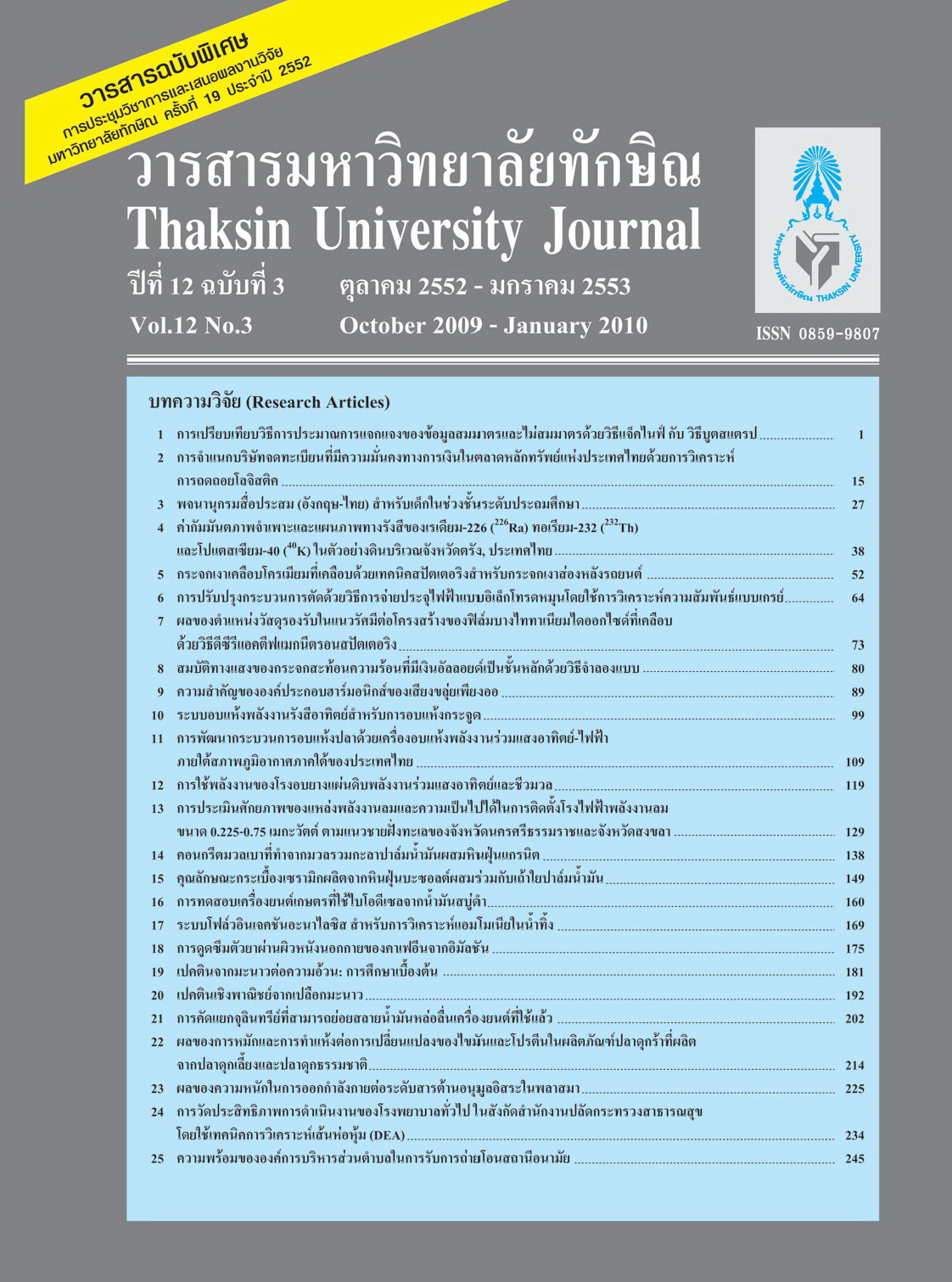ระบบอบแห้งพลังงานรังสีอาทิตย์สำหรับการอบแห้งกระจูด
Main Article Content
Abstract
งานวิจัยนี้ได้ศึกษาและพัฒนาระบบอบแห้งพลังงานรังสีอาทิตย์สำหรับอบแห้งกระจูด (Lepironia articulata) ซึ่งเป็นวัตถุดิบในการจักสานผลิตภัณฑ์เพื่อประโยชน์ใช้สอยและจำหน่ายของชาวบ้านชุมชนทะเลน้อย อำเภอควนขนุน จังหวัดพัทลุง ระบบอบแห้งนี้ประกอบด้วยแผงรับรังสีอาทิตย์ที่มีพื้นที่รับแสงขนาด 8.64 ตารางเมตร เป็นแหล่งความ ร้อนหลักและใช้น้ำเป็นตัวพาความร้อนไหลตามท่อทองแดงไปแลกเปลี่ยนกับอากาศชื้นภายในห้องอบแห้งที่มีความจุ 22.5 ลูกบาศก์เมตร โดยใช้ปั๊มน้ำขนาดกำลัง 745.7 วัตต์ ควบคุมอัตราการไหลของน้ำร้อนด้วยอัตรา 0.025 กิโลกรัมต่อวินาที ในกรณีที่แหล่งความร้อนหลักไม่พอเพียง ระบบอบแห้งจะใช้ขดลวดความร้อนขนาด 6 กิโลวัตต์ เป็นแหล่งความร้อน เสริม ซึ่งระบบอบแห้งสามารถควบคุมอุณหภูมิและความชื้นในห้องอบแห้งอย่างอัตโนมัติด้วยการประมวลผลของหน่วย ควบคุมพีแอลซี จากการทดสอบสมรรถนะของระบบอบแห้งพบว่าในการอบแห้งกระจูดจำนวน 22 กิโลกรัม ใช้อุณหภูมิ ในการอบแห้ง 40-60 องศาเซลเซียส ใช้เวลาในการอบแห้ง 16 ชั่วโมงต่อเนื่อง พบว่ามีประสิทธิภาพเชิงความร้อนสูงสุด ของการอบแห้ง 41.5 เปอร์เซ็นต์ และอุณหภูมิ 45 องศาเซลเซียส เหมาะสมที่สุดสำหรับการอบแห้งกระจูด สามารถลด ความชื้นในผลิตภัณฑ์เริ่มต้นจาก 167.03 เปอร์เซ็นต์มาตรฐานแห้ง เหลือ 9.56 เปอร์เซ็นต์มาตรฐานแห้ง ซึ่งได้กระจูดที่มี คุณภาพดี แห้งเร็วและแข็งแรงกว่าผลิตภัณฑ์ตากแห้งตามธรรมชาติ โดยมีกำลังต้านทานแรงดึงสูงสุดเท่ากับ 165 นิวตัน
This research studied and developed the solar dryer system which was built for drying a bulrush (Lepironia articulata) which is a raw material for weaving product in Talae Noi community. The solar dryer system consisted of a plat-plate solar collector with an area of collecting radiation of 8.64 m2. The water flowed through a closed loop copper tube and heat was transferred to the moist air in a dryer room of the volumetric capacity of 22.5 m3. The flow rate of water was 0.025 kg/s which was controlled by an electrical pump of 745.7 W. Whenever the heat was insufficient, the dryer system would automatically switched to an additional thermal source which was a 6 kW heater. The drying condition of the air in the dryer room was automatically controlled by the PLC unit. To test its performance, the 22 kg of a bulrush was dried in 40-60 ํC within 16 hours continuously. The experimental results showed that the maximum thermal efficiency of this system was 41.5 % and the optimal temperature of 45 ํC was suitable for reducing the initial moisture content of 167.03 %db down to the final moisture content of 9.56 %db. The dried bulrush products had good quality. The drying time for drying the bulrushes in this dryer was significantly shorter than the products dried with a natural sun drying and the bulrush was stronger than the other with a maximum tensile strength of 165 N.


